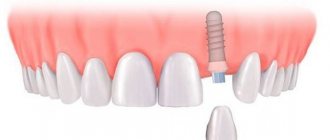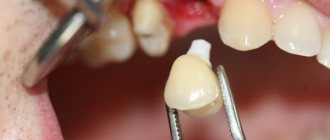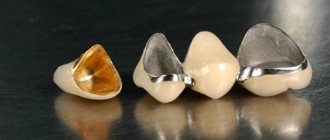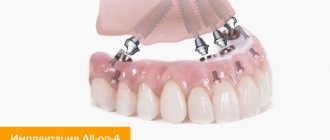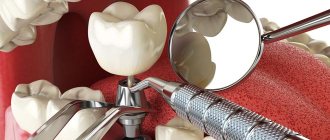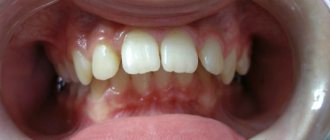26.11.2019
The choice of dentures is now quite large, but in case of incomplete tooth destruction, the most popular are dental crowns, which allow you to avoid removal. They are made in different ways, from different materials, and sometimes it can be difficult to choose the right option.
What is a crown and why is it needed?
A crown is a type of fixed dental prosthesis. Externally, it follows the shape of the tooth and, when installed, becomes indistinguishable from healthy teeth. It is used for incomplete tooth destruction to restore its chewing functions and aesthetic appearance, as well as to prevent further destruction. Crowns are differentiated depending on the material used to make them. They come in metal, metal-ceramic, plastic and ceramic. Metal ones are rarely used in modern clinics, as they have an unaesthetic appearance and are completely unsuitable for prosthetics of front teeth.
Ceramic ones have a natural appearance. This is the most expensive type of crown; they are made from zirconium oxide. Plastic crowns are used mainly as temporary prostheses, as they do not have durability and wear resistance, are easily subject to mechanical damage and fail. This is the cheapest type. Metal-ceramic crowns combine beauty and strength and are the most popular compared to other types because of their practicality. Dental crowns are also distinguished by the manufacturing method: there is a stamped crown and a solid cast one.
Stamped crowns. Manufacturing principles
The production of stamped crowns has been used for more than a hundred years; many dentists consider this process a relic of the past, but, nevertheless, it is still used because it is very cheap. Cylindrical blanks of different diameters are made from stainless steel, from which metal crowns are stamped on special machines. Such a product must have certain qualities for proper installation and comfortable wearing.
The stamped crown must fit exactly the size of the tooth, cover it tightly, without gaps or voids. Otherwise, it will provoke inflammation of the gums, which can lead to atrophy. For a tighter fit of the crown to the tooth and its fixation, special dental cement is used. The crown should not go deep into the gums, as this can cause gum disease, such as periodontitis. In addition, it must match the shape of a healthy tooth so as not to violate the integrity of the row, and be of an appropriate size to avoid injury. The product is designed to restore tooth function.
Indications and contraindications for the use of stamped crowns
Stamped metal crowns are used:
- In case of incomplete tooth decay. In this case, the tooth is ground to the required size, all its defects and carious lesions are eliminated to prevent further destruction.
- If removable dentures, for example, clasp or bridges, will be installed. Crowns are installed to protect supporting teeth.
- To restore a damaged baby tooth
There are some contraindications to their use:
- Bruxism (teeth grinding, which destroys enamel).
- Complete tooth destruction, in which there is nothing left to save.
- Infectious diseases of the oral cavity.
Indications and contraindications
Before installing a cast dental prosthesis, it is necessary to take into account all available indications and contraindications. Cast crowns are installed in the following cases:
- destruction of most of the tooth, when installation of a filling becomes impossible;
- to strengthen the lateral teeth and restore chewing function;
- when a pathological weakening of tooth enamel is detected in a patient;
- in case of mechanical injury leading to a chip or crack;
- to correct malocclusion;
- when diagnosing bruxism in a patient.
The main contraindication is the patient’s allergic reactions to any type of metal or metal alloy. In this case, you will have to resort to installing a denture structure made of hypoallergenic material.
A cast metal crown is not suitable for people suffering from hypersensitive teeth, since any type of metal has good thermal conductivity. Constant thermal exposure can lead to inflammation of the pulp. The teeth located on the opposite jaw will be regularly subjected to wear when in contact with metal, which will significantly worsen their condition.
Pros and cons of stamped crowns
Advantages of stamped crowns:
- Preparing the tooth does not require much time; grinding is carried out to a minimum, since the walls of the crown are thin. This is especially important if the product is attached to a healthy tooth, which will support a removable denture.
- This is a therapeutic procedure that allows you to preserve a healthy tooth and avoid extraction.
- A stamped crown can be used in cases where other types of prosthetics are not possible (for example, the use of implants cannot be carried out due to diabetes mellitus or another illness of the patient).
- This is a cheap method of manufacturing and prosthetics, so it becomes a salvation for people with low incomes.
Disadvantages of stamped crowns:
- Use for a long time leads to abrasion of the crown and its failure. Subsequently, the product will have to be replaced with a new one.
- The cement on which the crown is held dissolves over time, which leads to a loose fit to the tooth and gum. This, in turn, can lead to damage, tooth decay, and tooth decay due to food ingestion.
- If the tooth is completely destroyed, the crown will not help perform chewing functions.
- A stamped bridge contains welded parts that shorten its service life.
Solid crowns
Modern casting methods have made it possible to produce high-quality thin-walled crowns. A solid crown is used to restore the shape of a damaged tooth, its preservation, as a support for bridges and removable dentures. It is cast from a cobalt-chrome alloy, resulting in a solid product without solders. Even when creating bridge-like prostheses, soldering of elements is not required; the structure is poured out entirely. Such crowns can have various manufacturing options.
- Regular crown without coating, polished metal.
- Gold-plated crown. May cause allergic reactions. When worn for a long time, the coating wears off.
- Solid plastic crowns. They have a cast metal frame and a plastic onlay to give the aesthetic appearance of natural teeth. If worn for a long time or carelessly, the plastic may chip.
- Metal ceramics. The most expensive type of crowns, they have durability and a natural appearance.
Indications for the use of cast crowns:
- Significant damage to teeth.
- Pathology of the shape of the teeth or its location.
- Malocclusion.
- Anomaly in tooth size.
- Support for removable and bridge dentures.
- Prevention of tooth abrasion, bruxism.
Stages of manufacturing a crown from CHS
An all-metal crown made of cobalt-chrome alloy (CHS) is perfect for those people who do not have allergic reactions to metal. An orthopedic design made from CCS is inexpensive and therefore available to all segments of the population.
Due to the fact that this type of dental prosthesis is made by pouring into a mold, a dental technician can quickly create not only a single structure, but also an imitation of several elements of the dentition. The casting method significantly simplifies and speeds up the process of making crowns.
If the patient has already had prostheses of this type installed and they require replacement, then they can quickly be replaced with cast crowns. The stages of manufacturing an all-metal crown include:
- selection of material;
- taking impressions of the jaw;
- creating a filling mold;
- pouring a metal alloy into a mold;
- adjustment of the resulting product.
The manufactured prosthesis must not only correspond to the general contour of the tooth being prosthetized, but also exactly repeat its shape. If this condition is violated, the patient may experience complications associated with inflammation of the jaw joint. A properly made crown will save the patient from problems with long-term adaptation to the prosthesis, as well as preserve the original bite and fully restore chewing function.
Advantages of cast crowns
- The possibility of one-piece production of not only individual crowns, but also bridges, which ensures the strength and wear resistance of the products.
- Durability. Wearing such crowns can last up to 10 years if the quality of the material and installation are performed at a high level.
- Fast and easy production.
- A one-piece crown is made individually for each tooth and fits perfectly into the dentition without causing discomfort when worn.
- The precision of the design allows the crown to be installed tightly without gaps, which protects against bacteria and food getting under it.
- For front teeth, it is possible to produce crowns with coating or veneering for an aesthetic appearance. A stamped crown does not provide this opportunity.
Types of metal crowns for teeth
According to manufacturing technology, metal crowns for teeth can be stamped or solid.
Stamped
This is a budget option. To make a stamped metal crown, standard sleeves are used, which are given the required shape, resembling a case. Tooth preparation for a stamped metal crown requires the bare minimum, since it has very thin walls. Depulpation is not necessary for installation. For fixation, you need at least a third of the dental crown and a healthy root. Among the disadvantages of the design: incomplete restoration of chewing function, rapid wear, loose fit to hard tissue.
Cast
The production of a cast metal crown is made from individual impressions by casting. These are very durable structures, resistant to corrosion, they are very durable. Since solid crowns are manufactured exclusively, the risk of incomplete fit, and therefore the penetration of bacteria under the crown, is eliminated. The downside is that the preparation of teeth for a metal crown in this case requires quite significant preparation.
Types of solid metal crowns:
- simple;
- with spraying;
- with ceramic lining.
*Metal crowns on teeth with a white ceramic coating are practically indistinguishable from natural teeth, but their service life is much shorter than those made entirely of metal.
You should consult with your doctor about which metal crowns are best for a particular patient and how much it costs to install a metal crown from the selected material.

